According to Wikipedia's ESP32 page:
page:
ESP32 is a series of low-cost, low-power system on a chip microcontrollers
microcontrollers with integrated Wi-Fi
with integrated Wi-Fi and dual-mode Bluetooth
and dual-mode Bluetooth . The ESP32 series employs a Tensilica
. The ESP32 series employs a Tensilica Xtensa LX6 microprocessor in both dual-core and single-core
Xtensa LX6 microprocessor in both dual-core and single-core variations and includes built-in antenna switches, RF balun
variations and includes built-in antenna switches, RF balun , power amplifier, low-noise receive amplifier, filters, and power-management modules. ESP32 is created and developed by Espressif Systems
, power amplifier, low-noise receive amplifier, filters, and power-management modules. ESP32 is created and developed by Espressif Systems , a Shanghai-based Chinese company, and is manufactured by TSMC
, a Shanghai-based Chinese company, and is manufactured by TSMC using their 40 nm process.[2] It is a successor to the ESP8266
using their 40 nm process.[2] It is a successor to the ESP8266 microcontroller.
microcontroller.
 microcontrollers
microcontrollers with integrated Wi-Fi
with integrated Wi-Fi and dual-mode Bluetooth
and dual-mode Bluetooth . The ESP32 series employs a Tensilica
. The ESP32 series employs a Tensilica Xtensa LX6 microprocessor in both dual-core and single-core
Xtensa LX6 microprocessor in both dual-core and single-core variations and includes built-in antenna switches, RF balun
variations and includes built-in antenna switches, RF balun , power amplifier, low-noise receive amplifier, filters, and power-management modules. ESP32 is created and developed by Espressif Systems
, power amplifier, low-noise receive amplifier, filters, and power-management modules. ESP32 is created and developed by Espressif Systems , a Shanghai-based Chinese company, and is manufactured by TSMC
, a Shanghai-based Chinese company, and is manufactured by TSMC using their 40 nm process.[2] It is a successor to the ESP8266
using their 40 nm process.[2] It is a successor to the ESP8266 microcontroller.
microcontroller.
Recently the ESP32 has been featured in a series of Single Board Computers (SBC) designed by Seon Rosenblum of Unexpected Maker , in the "Nano" (13x27mm), "Tiny" (18x32mm and 18x35mm) and "Feather" (23x51mm) form factors. These boards all have WiFi and support CircuitPython and MicroPython. The TinyPico boards are available with either USB Micro-B or USB-C power connectors.
, in the "Nano" (13x27mm), "Tiny" (18x32mm and 18x35mm) and "Feather" (23x51mm) form factors. These boards all have WiFi and support CircuitPython and MicroPython. The TinyPico boards are available with either USB Micro-B or USB-C power connectors.
TinyPico NANO#
Features & Specifications: #
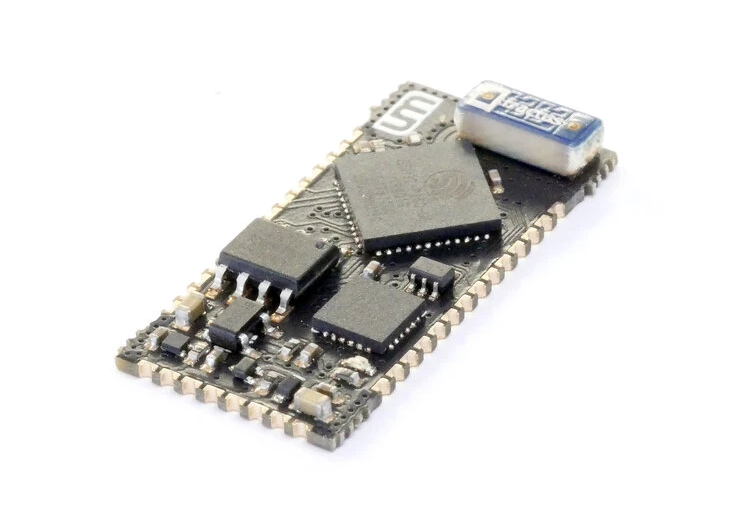 |
- 32 bit Dual Core 240MHz
- 2.4GHz Wifi - 802.11b/g/n
- Bluetooth BLE 4.2
- 4MB SPI Flash
- 4MB Extra PSRAM
- USB + Serial/UART for programming
- 700mA 3.3 LDO Regulator
- LIPO Battery Management
- Optimised power path for low power battery usage
- VBAT pin for battery connection
- Enable pin for LDO on/off control
- 27x GPIO pins available
- dimensions: 13x17mm
Links#
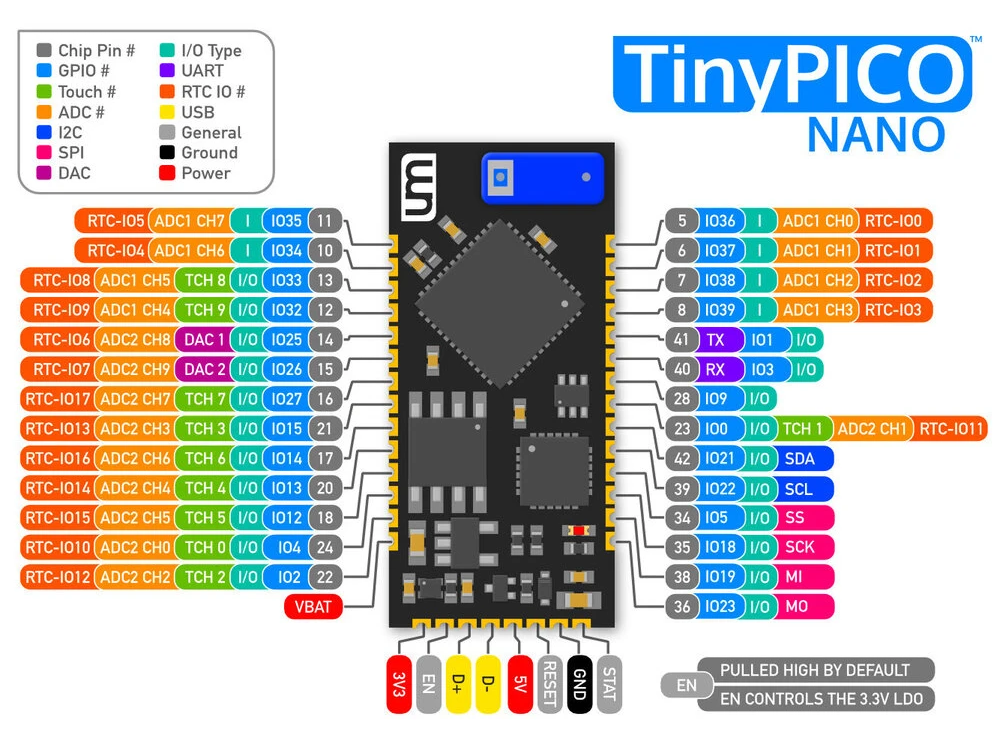 |
- TinyPICO NANO product page
 on Pimoroni
on Pimoroni
- Microdot - Web Framework to Micropython

- on github: https://github.com/miguelgrinberg/microdot

- on github: https://github.com/miguelgrinberg/microdot
- ESPAsyncWebServer
 , a web server written in PlatformIO/C
, a web server written in PlatformIO/C
TinyPico V2 Micro-B and USB-C#
Features & Specifications#
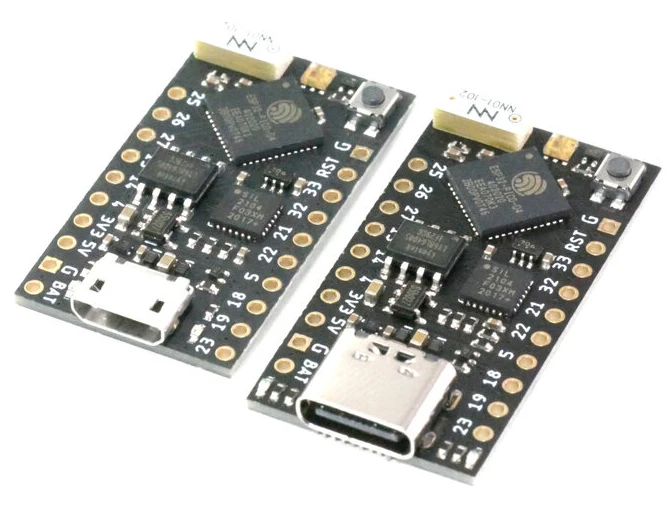 |
- Processing:
- 32-bit dual-core processor operating at 240 MHz
- 4 MB SPI flash
- 4 MB extra PSRAM
- Wireless:
- 2.4 GHz Wi-Fi - 802.11b/g/n
- Bluetooth BLE 4.2
- 3D antenna
- Power:
- 700 mAh 3.3 V LDO regulator
- Optimized power path for low-power battery usage
- LiPo battery management
- Battery pads on the bottom support both JST PH & MicroBlade connectors (included unassembled with every TinyPICO)
- Power (red) & charge (orange) LEDs
- Form-factor:
- Breadboard-friendly
- Oh, it’s tiny! Just 18 mm x 32 mm
- Connectivity:
- 14x GPIO broken out to standard pitch headers
- USB + serial/UART for programming
- APA102 RGB LED
- Control:
- MicroPython pre-installed
- Supports Arduino IDE
- Supports Espressif IDF
- Lots of example code and libraries
Links#
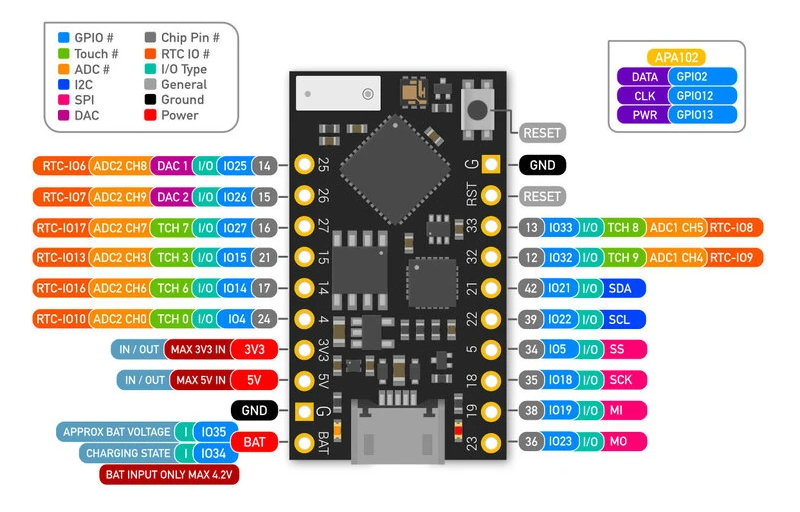 |
- TinyPICO V2 – USB Micro-B product page
 on Pimoroni
on Pimoroni
- TinyPICO V2 – USB Micro-B product page
 on Adafruit
on Adafruit
- TinyPICO V2 – USB-C product page
 on Pimoroni
on Pimoroni
FeatherS2#
Features & Specifications#
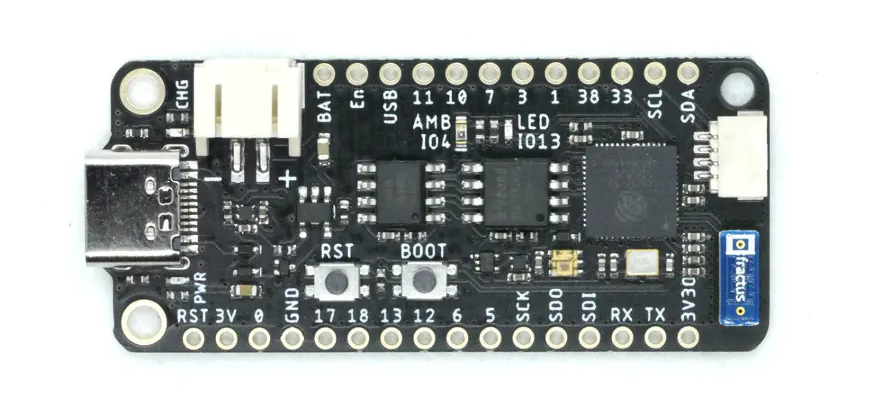 |
- 32-bit 240 MHz single-core processor
- 16 MB SPI Flash
- 8 MB extra PSRAM
- 2.4 GHz Wi-Fi - 802.11b/g/n
- 3D Antenna
- 2x 700 mA 3.3 V LDO regulator
- Optimised power path for low-power battery usage
- LiPo battery management
- Power (red), Charge (orange) & IO13 (blue) LEDs
- 21x GPIO
- USB-C
- USB backfeed protection
- APA102 RGB LED (CLK IO45, DATA IO40)
- ALS-PT19 Ambient Light Sensor (IO14)
- QWIIC/STEMMA connector
- Feather format
Links#
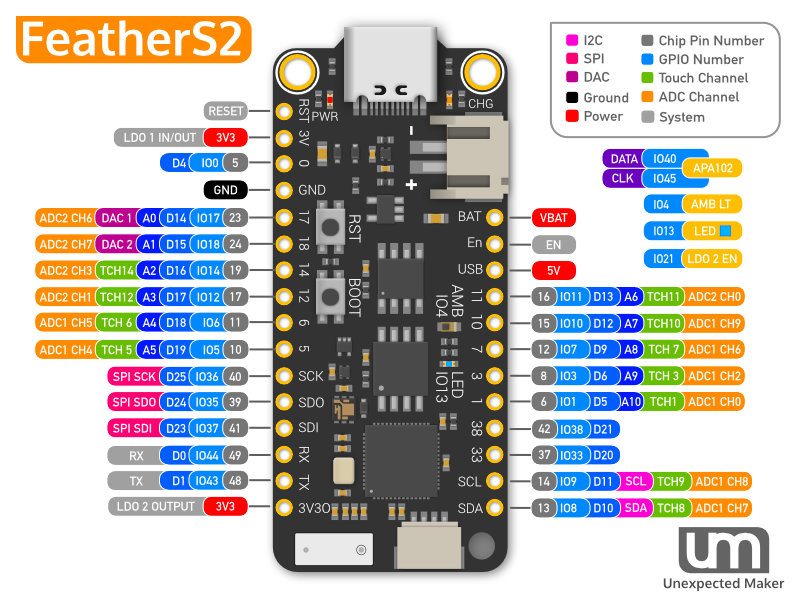 |
- FeatherS2 home page

- FeatherS2 product page
 on Pimoroni
on Pimoroni
- FeatherS2 product page
 on Adafruit
on Adafruit
Links#
- The ESP32
 page on Wikipedia
page on Wikipedia
- TinyPico home Page

- TinyPico Getting Started Guide

- TinyPico code
 on github
on github